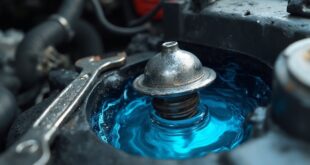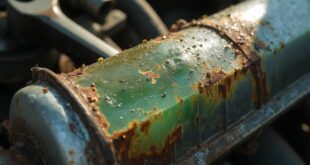A cold lower radiator hose can indicate several issues within the cooling system. It may result from a faulty thermostat, malfunctioning water pump, or low coolant levels, which can create air pockets. Additionally, a clogged cooling system can restrict fluid flow. During normal operation, both hoses should be hot if the engine is at ideal temperature. Understanding the causes and symptoms can help in diagnosing this problem effectively. More information will provide deeper insights into resolving these issues.
Understanding the Cooling System
Although many car owners are familiar with the basic function of their vehicle's cooling system, a deeper understanding reveals its complexity and importance. The system is designed to regulate engine temperature, preventing overheating and ensuring peak performance.
It comprises several components, including the radiator, water pump, thermostat, and hoses, each playing a vital role in coolant circulation. The upper radiator hose carries hot coolant from the engine to the radiator, while the lower hose returns the cooled fluid.
Understanding these interactions helps car owners recognize symptoms of potential issues, ultimately enhancing vehicle longevity and performance.
Causes of a Cold Lower Radiator Hose
When a car's lower radiator hose remains cold, it can indicate several potential issues within the cooling system.
A faulty thermostat may fail to regulate coolant flow, causing both overheating and a cold hose.
Additionally, a malfunctioning water pump can prevent proper circulation, leading to stagnant coolant.
Low coolant levels can create dangerous air pockets, while trapped air in the system may result from a faulty head gasket or improper bleeding.
Finally, a clogged coolant system due to rust buildup from incorrect fluid use can obstruct flow, contributing to the cold hose condition.
Normal Operating Conditions for Radiator Hoses
Understanding the normal operating conditions for radiator hoses is essential for diagnosing potential issues within a vehicle's cooling system.
During typical operation, both hoses should be hot when the engine reaches its best temperature, indicating proper coolant circulation. Initially, the lower hose may remain cold as the thermostat is closed during engine warm-up.
In cold weather, lower hose temperatures can also be affected if the thermostat does not fully open. Ideally, the upper hose should be hotter than the lower, reflecting effective coolant flow.
Infrared measurements can provide accurate assessments of hose temperatures during operation.
Symptoms of Cooling System Issues
What signs indicate potential issues within a vehicle's cooling system?
One prominent symptom is a radiator that feels half hot and half cold, suggesting possible clogging and restricted coolant flow.
Overheating under load is another red flag, often seen in neglected vehicles due to insufficient coolant circulation.
A soft lower hose may indicate pressure problems, as it should feel firm when the system is operating correctly.
Additionally, air pockets can lead to erratic temperature readings, while a clogged radiator can diminish cooling effectiveness, especially during demanding driving conditions.
Recognizing these symptoms is essential for timely maintenance and repairs.
Troubleshooting Cold Lower Radiator Hose
How can a vehicle owner effectively troubleshoot a cold lower radiator hose?
First, they should examine the coolant level, ensuring it is adequate to prevent air pockets.
Next, they must inspect the thermostat, verifying it opens and closes at the proper temperatures.
Third, monitoring the water pump for unusual noises or leaks is essential, as its performance directly affects coolant circulation.
Finally, if clogging is suspected, a system flush may be necessary to restore flow and efficiency.
- Check coolant level
- Inspect thermostat function
- Monitor water pump operation
- Flush cooling system if needed
Importance of Regular Maintenance
Regular maintenance plays a significant role in preventing issues such as a cold lower radiator hose.
Routine checks of the coolant level, thermostat functionality, and water pump operation can identify potential problems before they escalate. Flushing the cooling system periodically guarantees peak coolant flow and prevents clogging.
By adhering to a maintenance schedule, vehicle owners can mitigate the risk of overheating and other cooling system failures.
Additionally, regular inspections can help detect air pockets and leaks, ultimately maintaining the efficiency and longevity of the vehicle's cooling system.
Consistent care is essential for reliable vehicle performance and overall safety.
When to Seek Professional Help
When experiencing persistent issues with a cold lower radiator hose, it is essential to recognize the signs that warrant professional intervention. Ignoring these indicators can lead to significant engine damage.
The following situations should prompt a visit to a mechanic:
- Overheating Engine: Consistent overheating can indicate serious coolant flow issues.
- Soft Lower Hose: A soft hose may suggest a pressure problem that requires attention.
- Unusual Noises: Sounds from the water pump may signal malfunction.
- Low Coolant Levels: Frequent low coolant levels could indicate leaks or system failures.
Addressing these issues early can prevent costly repairs.
Frequently Asked Questions
Can a Cold Lower Radiator Hose Indicate a Coolant Leak?
A cold lower radiator hose may suggest a coolant leak if the engine is hot and operating normally. Insufficient coolant flow often results from leaks, leading to temperature discrepancies and potential overheating issues.
How Does the Weather Affect My Radiator Hose Temperatures?
Weather considerably influences radiator hose temperatures; colder conditions can prevent the thermostat from opening fully, resulting in lower temperatures in the lower hose. Conversely, warmer weather promotes better coolant circulation, leading to more consistent temperatures.
Is It Safe to Drive With a Cold Lower Radiator Hose?
Determining the safety of driving with a cold lower radiator hose depends on overall engine temperature and performance. If other indicators remain normal, it may be safe, but potential issues should be investigated promptly.
Will Using a Different Coolant Affect Hose Temperature?
Using a different coolant can affect hose temperature by altering thermal conductivity and flow properties. If the new coolant is incompatible, it may lead to inadequate circulation, potentially causing abnormal temperature readings in the radiator system.
Can a Faulty Radiator Cap Cause a Cold Lower Hose?
A faulty radiator cap can lead to coolant flow issues, potentially causing the lower radiator hose to remain cold. Proper pressure maintenance is essential for ideal circulation and temperature regulation within the cooling system.
 Car Service Land Coupons for Oil change, Tires, Wheel alignment, Brakes, Maintenance
Car Service Land Coupons for Oil change, Tires, Wheel alignment, Brakes, Maintenance




